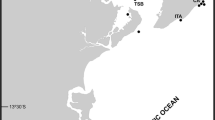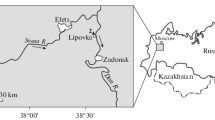Abstract
Seven species of marine bryozoans were examined for the presence of bacteria associated with the larvae. In three species (Bugula neritina, B. pacifica, and B. simplex), rod-shaped bacteria were consistently observed in the pallial sinus of the larvae, independent of geographic location, year, or season. Larvae of closely related bryozoans (B. stolonifera, B. turrita, Scrupocellaria bertholetti, and Tricellaria occidentalis) occurring sympatrically with those containing bacteria lacked this apparent symbiosis. Those bryozoans examined that possessed the bacteria-larva association are among the most frequently encountered fouling bryozoans.
Similar content being viewed by others
Literature Cited
Cavanaugh, C. M., S. L. Gardiner, J. L. Jones, H. W. Jannasch and J. B. Waterbury: Prokaryotic cells in the hydrothermal vent tube worm Riftia pachyptila Jones: possible chemoautotrophic symbionts. Science, N.Y 213, 340–342 (1981)
Geilenkirchen, W. L. M., L. P. M. Timmermans, C. A. M. Van Dogen and W. J. A. Arnolds: Symbiosis of bacteria with eggs of Dentalium at the vegetal pole. Expl. Cell Res. 67, 477–478 (1971)
Hastings, J. W. and K. H. Nealson: The symbiotic luminous bacteria. In: The procaryotes, Ed. by M. P. Starr, H. Stolp, H. G. Truper, A. Balows and H. G. Schlegel. Berlin: Springer-Verlag (In press)
Holland, N. D. and K. H. Nealson: The fine structure of the echinoderm cuticle and the subcuticular bacteria of echinoderms. Acta zool., Stockh. 59, 169–185 (1978)
Lévi, C. et P. Lévi: Embryogenèse de Chondrosia reniformis (Nardo), démosponge ovipare, et transmission des bactéries symbiotiques. Annls Sci. nat. (sér. b, Zool.). 18, 367–380 (1976)
Lutaud, G.: La nature des corps funiculaires des cellularines, bryozoaires chilostomes. Archs Zool. exp. gén. 110, 2–30 (1969)
Mackie, G. O. and Q. Bone: Luminescence and associated effector activity in Pyrosoma (Tunicata: Pyrosomida). Proc. R. Soc. (Ser. B) 202, 483–495 (1978)
Trench, R. K.: The cell biology of plant-animal symbiosis. A. Rev. Pl. Physiol. 30, 485–531 (1979)
Vacelet, J. and C. Donadey: Electron microscope study of the association between some sponges and bacteria. J. exp. mar. Biol. Ecol. 30, 301–314 (1977)
Woollacott, R. M. and R. L. Zimmer: A simplified placenta-like system for the transport of extraembryonic nutrients during embryogenesis of Bugula neritina (Bryozoa). J. Morph. 147, 355–378 (1975)
Woollacott, R. M. and R. L. Zimmer: Metamorphosis of cellularioid bryozoans. In: Settlement and metamorphosis of marine invertebrate larvae, pp 49–64. Ed. by F.-S. Chia and M. E. Rice. New York: Elsevier/North-Holland 1978
Author information
Authors and Affiliations
Additional information
Communicated by N.D. Holland, La Jolla
Rights and permissions
About this article
Cite this article
Woollacott, R.M. Association of bacteria with bryozoan larvae. Mar. Biol. 65, 155–158 (1981). https://doi.org/10.1007/BF00397080
Accepted:
Issue Date:
DOI: https://doi.org/10.1007/BF00397080




